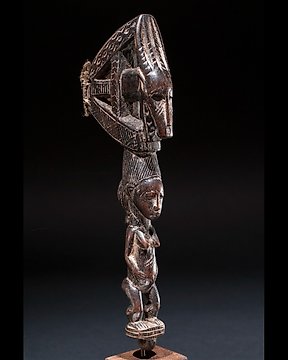
Gong hammare - Baule - Elfenbenskusten
Nr 82986263

Nr 82986263

A Baule Equestrian figure from Ivory Coast, horse appears very small in comparison to the rider, with sturdy legs, rounded buttocks, wearing a loincloth, a slender torso with a projecting navel, emphasised pectoral muscles and nipples, the torso decorated with scarification marks on the front and the backside, rounded shoulders also with scarification on the deltoids, armlets on both arms carved close to the body and angled, holding the rein in his right hand, an elongated cylindrical neck with scarifications on both sides supporting an oval head with with a beard that runs on the side of the jaws to connect on long goatee that ends on a bulb; a full rounded mouths, a broad flattened nose, the thick high arched brows connected and merging into the nose, round eyes, small ears, further scarification marks on the temples and the centre of the forehead; wearing a colonial pit helmet. Certificate of origin and provenance.
The importance of equestrian figures in West Africa has a dual function. On the one hand, the horse is closely linked to the colonial rulers of the 19th century. Because the colonialists came from far away with their horses in good condition, the horse became a symbol of a good and safe journey.
On the other hand, the horse was also a symbol of power. The colonial tax collectors usually came into the villages on horseback and with their exotic animals they knew how to appear quite frightening. To avoid this, equestrian figures were sacrificed. This was believed to keep the mounted tax collectors away.
Source: Interview with the Lobi informant Binaté, village Gbomblora, Gaoua, region Poni, Burkína Faso, by Wolfgang Jaenicke.
Hur du köper på Catawiki
1. Upptäck något speciellt
2. Lägg det högsta budet
3. Gör en säker betalning